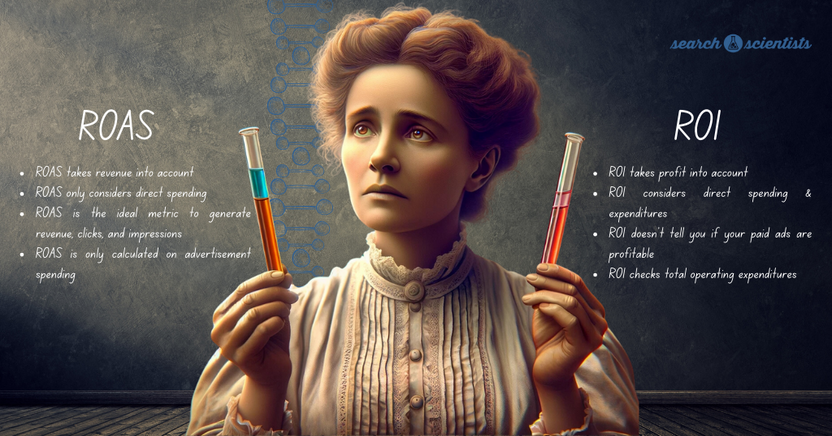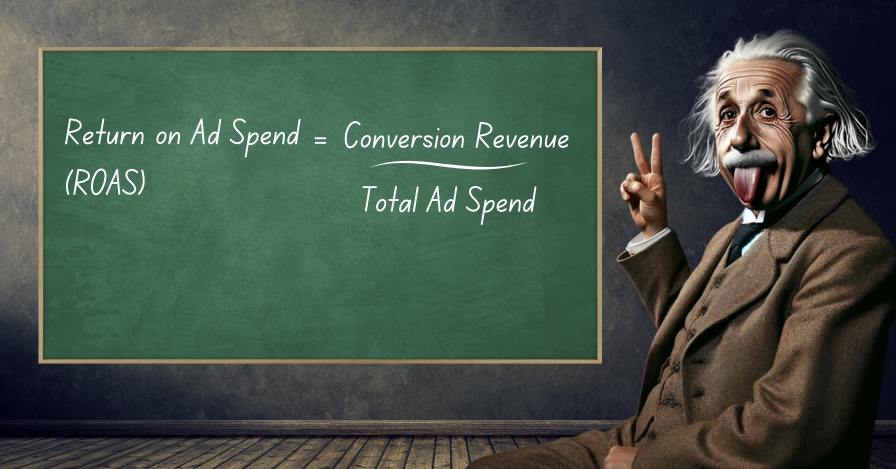Calculate ROAS — a crucial step for evaluating your ad performance. This metric, known as Return on Ad Spend, effectively aligns your advertising investment with revenue outcomes. Firstly, here you’ll find a practical guide to calculating ROAS. Moreover, you’ll also learn how it significantly impacts your strategy and how to use it to boost your campaign for better results. Ready to learn how to calculate ROAS with Search Scientists?
Everything that the article covers:
The important thing is not to stop questioning. Curiosity has its own reason for existing.
Albert Einstein
Core Scientific Discoveries:
ROAS is key for checking if ads work well. It helps decide how much to spend. Getting it right is a must. You also should know how it’s different from ROI to use it effectively.
The ROAS formula is easy: just divide what you earn from ads by what you spend on them. But, you need to make sure your earnings data is accurate and watch how much you’re spending closely. A ‘good’ ROAS usually means you’re making three to four times what you spend.
To make the most of your ad campaigns with ROAS, you need to set clear goals, try out different approaches (A/B testing), and really get who your audience is. Using data on how users act is crucial. Nowadays, AI and machine learning are game-changers. They can guess future trends and help spend your budget smarter to get a better ROAS.
What Is ROAS and Why Is It Crucial for Digital Marketing?
ROAS, or Return on Ad Spend, is a powerful tool in digital marketing. It’s like a map for marketers, guiding them through the tricky world of ad campaigns to find what really works. It also helps them make smart choices on how much to spend. By looking at what you spend on ads versus what you make from them, ROAS shows how effective your ad money is. This helps you see clearly if your ads are truly bringing in value.
A strong ROAS shows targeted ads and careful budgeting. Tracking ROAS isn’t just about seeing how your campaigns are doing right now. It gives you clues that help plan your next moves in marketing. No matter if you’re experienced or just starting out, getting how ROAS works is crucial. It’s a key skill everyone in the digital marketing world needs.
Next up, we’ll show you how to figure out ROAS with a simple formula. Ready?
Why Should You Calculate ROAS?
Сalculating ROAS is of utmost significance. What strategies really make your ads work better? ROAS lights the way to smart spending and effective ads. By using the ROAS formula and keeping an eye on it, marketers can tell which moves pay off and which don’t. This helps them plan their campaigns more cleverly.

How do you decide what a good ROAS looks like for your business? Picking a solid ROAS goal steers you toward profitable marketing. It changes depending on the industry, as profit margins and different rules play a big part. So, when companies figure out their ROAS, they aim for a target that matches their money goals. This makes sure each dollar spent on ads could lead to earning more back.
What Is the Difference Between ROAS and ROI?
What makes marketing metrics different from each other? To get it, you really need to look closely at each one. You need to know ROAS from ROI. ROAS focuses on ad revenue. ROI measures how much money you make from your investment, covering more types of costs. To make the best decisions, you must understand the role of each marketing metric. They help you test the success of your campaigns.
How can understanding ROAS and ROI help avoid costly mistakes? It’s like using scientific tools for exact measurements. ROAS works like a microscope. It zooms in on how well ads perform. ROI acts like a telescope. It gives a broad view of overall profit, including all costs. Knowing their differences prevents errors. For example, you might avoid thinking you’re successful with a high ROAS when your overall ROI is actually poor.
How to calculate ROAS: Formula
How do you know if your ads are worth the money? The ROAS formula is easy but important. Just divide the money you make from ads by what you spent on them. This easy math helps you see if your ads are doing well. It also helps you decide how to spend on ads in the future.
Being exact is key. In calculating ROAS, only count the money spent on ads. This shows if your campaign really worked. Picking the right numbers is crucial. It’s the foundation for figuring out ROAS accurately.
What Are the Key Parts of ROAS?
Two key elements in the calculation of ROAS are revenue and ad spend. The integrity of your revenue data is vital. Ad spend roas decisions hinge on its truth. This means verifying transactions to exclude fraud. This includes adjusting for refunds or cancellations. Additionally, іt also involves considering net figures after taxes and other deductions.
It’s also about context. A good ROAS could be misleading. We must compare it to the company’s profit. Remember, finding the break-even ROAS is crucial. It’s the point at which ads start making money, crucial for keeping an ad campaign profitable.
How Can You Calculate ROAS Step by Step?
Our step-by-step guide makes the process of calculating ROAS straightforward. Here’s how to do it:
- Take the revenue generated by the ad campaign.
- Divide it by the campaign’s cost.
- For instance, if your ad campaign costs $5,000 and it results in $25,000 of revenue, the ROAS would be $25,000 / $5,000.
- This equates to a $5 return for every $1 spent.
What makes up a ‘good’ ROAS? Generally, people consider a ratio of at least 3:1 or 4:1 good. For every dollar spent, one earns three or four dollars. So, if you’re spending on ads, your aim is to make at least three or four times that amount. It’s a sign that your ads are doing their job.
How Can ROAS Data Optimize Your Ad Campaigns?
Once you have the ROAS data, you can use it to optimize your ad campaigns. It’s a dynamic tool. Wielded well, it can improve your advertising. How can businesses use ROAS?
- Start by setting goals.
- Test a lot to see what works.
- Focus on people who are likely to buy.
- Work on getting more clicks and sales.
View ROAS as a forward-looking instrument beyond mere number-crunching. ROAS is not about rating the past. It’s also about using insights to plan for the future. By watching and adjusting campaigns based on ROAS, businesses can avoid ad fatigue. They can keep consumer engagement, which is key for a good return on ad spend.
The Power of A/B Testing
A/B testing is a fundamental aspect of campaign optimization. This methodical approach lets marketers compare different ad variations head-to-head. It shows which ones resonate most with the target audience and contribute to a higher ROAS. It’s a process of trial and error. What methods are used to pinpoint the most effective combinations in a campaign? This involves refining ad copy and creative elements to identify the pairs that are both compelling and profitable.

Also, A/B testing can affect cost per click (CPC). CPC is a direct factor in calculating ROAS. Optimizing the ad-to-page experience helps marketers. It boosts user engagement and cuts ad costs. This makes their campaigns more effective.
Knowing Your Target Audience
Understanding your target audience is the secret to achieving a high ROAS. They can delve into demographics, behaviors, and preferences. How can matching content to audience expectations lower ad costs and boost returns? By crafting campaigns that resonate and encourage sales, marketers can deliver content that aligns with what the audience expects. This strategy not only lowers ad costs but also enhances returns, optimizing the overall efficiency of the campaign.
How does good targeting improve your ad results? It’s not just about knowing who your audience is. It’s also guessing what they’ll want and giving them something that really hits home. When you get this right, not just one, but all of your ad efforts do way better. You can tell it’s working when you see a big jump in how much return you get for what you spend on ads.
Leveraging User Behavior Data
How can tracking what users do help you spend better on ads? Looking at user actions gives you tons of clues on how to make your ads work harder. It helps you figure out which ads to show more and which to stop. This cuts down on wasting money on ads that don’t work. By focusing on ads that really click with the people most likely to buy, marketers can make their campaigns work better and clearly see their ad spending pay off.
The refinement doesn’t stop at targeting. It extends to personalizing the ad-to-page journey. It also enhances customer relations and builds brand loyalty. These focused efforts are often informed by A/B testing. They give marketers an edge and improve ROAS.
Can AI Improve Your ROAS?
AI and machine learning have started a new chapter. They’ve changed how we advertise and market. By making data analysis and ad campaign tuning automatic, they’ve made things way more efficient. These tech tools really help out:
- Using user behavior to predict successful strategies.
- Enabling advertisers to focus their budget on the most profitable campaigns.
- Setting high targets for ad spend returns.
AI is making a big difference in how we do ads on different websites and social media, where each place has its own kind of users. It’s making it easier to handle and get better results from ads, helping marketers solve old problems and get more money back from what they spend. With AI, managing ads is becoming smoother, and it’s showing in numbers: marketers are seeing their ad returns go up.
AI-Powered Advertising Platforms
AI-powered advertising platforms are transforming how marketers calculate and analyze ROAS. These platforms automate complex processes, providing real-time insights that optimize campaign performance. MMPs have become vital. They attribute app downloads and purchases to campaigns. They offer the detail needed for precise ROAS assessment.
How you can use AI’s potential in marketing to stay ahead?
- Target more qualified customers
- Optimize ad spend
- Magnify the effectiveness of digital marketing efforts
- Elevate ROAS to new heights.
Using AI tools like TensorFlow for deep learning is valuable. It enhances ROAS. Additionally, leveraging Google Analytics’ predictive metrics facilitates effective forecasting. Furthermore, employing chatbots like Sprinklr enables personalized customer interactions. Together, these tools are crafted to make ad targeting easier. They also optimize budget allocation.
Summary
Basically, getting a good ROAS isn’t just about looking back at how ads did before. It’s about planning your marketing carefully. Knowing how to calculate ROAS helps marketers use data and AI to better plan and spend on ads. Think of these tips as your guide to keep getting better at online ads.
Frequently Asked Questions
What does a 2.5 ROAS mean?
A ROAS of 2.5 means that for every dollar spent on advertising, you are making $2.50 in revenue. You are earning 2.5 times what you spent. This helps you understand the profitability of your ad campaign.
What is the math for ROAS?
To calculate ROAS, divide the revenue from your ad campaign by the cost of the campaign. For example, if you spend $1,000 on ads and generate $2,000 in revenue, your ROAS is 200%.
What is a good ROAS ratio?
Many people believe a 4:1 ROAS ratio is good. It means that $4 in revenue is generated for every $1 spent on advertising. But, the ideal ratio can vary based on factors such as profit margins and business health.
What is ROAS and why is it important?
ROAS stands as a pivotal metric in digital marketing, evaluating the effectiveness of ads by comparing revenue to ad spend. Not only is it significant, but it also plays a guiding role in budgeting and campaign strategy.
Our mission is to help businesses grow through science-based PPC optimization strategies. Ready to see real results? Click to contact us now.

Crafting Effective Demand Gen Campaigns: Best Practices for 2025






